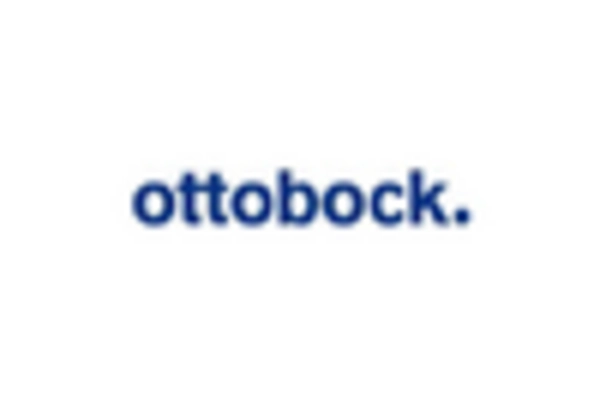Rising Healthcare Expenditure
The increasing healthcare expenditure in South America is a significant driver for the knee replacement market. Governments and private sectors are allocating more funds towards healthcare services, which includes orthopedic surgeries. Reports suggest that healthcare spending in the region has grown by approximately 5% annually, reflecting a commitment to improving medical infrastructure and access to advanced treatments. This financial support enables hospitals to acquire state-of-the-art equipment and technologies necessary for performing knee replacements. As patients gain better access to surgical options, the demand for knee replacement procedures is expected to rise. Furthermore, the emphasis on improving healthcare quality may lead to more favorable reimbursement policies, further encouraging the growth of the knee replacement market.
Advancements in Surgical Techniques
Innovations in surgical techniques are transforming the knee replacement market in South America. Minimally invasive procedures, such as arthroscopy, are gaining traction, offering patients reduced recovery times and less postoperative pain. These advancements not only enhance patient outcomes but also increase the number of surgeries performed annually. For instance, the adoption of robotic-assisted surgery has shown to improve precision and reduce complications, making knee replacements more appealing to both patients and surgeons. As healthcare facilities invest in advanced surgical technologies, the overall efficiency and effectiveness of knee replacement procedures are likely to improve, thereby stimulating market growth. The potential for enhanced patient satisfaction and reduced hospital stays may further contribute to the expansion of the knee replacement market.
Increased Awareness of Joint Health
The growing awareness of joint health among the South American population is influencing the knee replacement market. Educational campaigns and health initiatives are promoting the importance of maintaining joint function and addressing issues like arthritis early on. As individuals become more informed about treatment options, including knee replacements, they are more likely to seek medical advice and intervention. This shift in mindset is particularly evident among the aging population, who are increasingly proactive about their health. The potential for early diagnosis and timely surgical intervention could lead to improved outcomes and higher patient satisfaction. Consequently, this heightened awareness is likely to drive demand for knee replacement surgeries, positively impacting the knee replacement market.
Expansion of Health Insurance Coverage
The expansion of health insurance coverage in South America is a pivotal driver for the knee replacement market. As more individuals gain access to comprehensive health insurance plans, the financial barriers to undergoing knee replacement surgeries diminish. This trend is particularly relevant in countries where public health systems are evolving to include more surgical options. With increased coverage, patients are more inclined to pursue knee replacements, knowing that a significant portion of the costs will be covered. This shift not only enhances patient access to necessary treatments but also encourages healthcare providers to offer more knee replacement procedures. The resulting increase in surgical volume is expected to contribute to the overall growth of the knee replacement market.
Increasing Prevalence of Osteoarthritis
The rising incidence of osteoarthritis in South America is a critical driver for the knee replacement market. As populations age, the prevalence of this degenerative joint disease escalates, leading to a higher demand for knee replacement surgeries. Studies indicate that approximately 30% of adults over 65 years in the region experience osteoarthritis symptoms, which significantly impacts their quality of life. This growing health concern necessitates effective treatment options, including surgical interventions. Consequently, healthcare providers are increasingly adopting knee replacement procedures to address the needs of this demographic. The economic burden associated with osteoarthritis management further emphasizes the importance of surgical solutions, potentially driving market growth in the knee replacement market.


















Leave a Comment